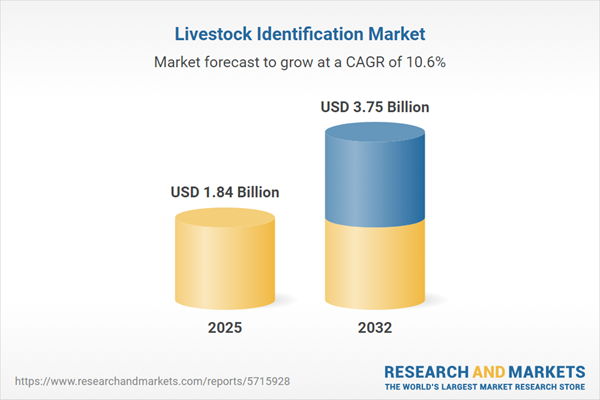Speak directly to the analyst to clarify any post sales queries you may have.
The livestock identification market is experiencing rapid transformation, driven by technological integration, stricter regulations, and growing demands for supply chain transparency. As key sectors align toward digital solutions, senior decision-makers face both opportunities and challenges in optimizing their identification systems for a more resilient, traceable, and efficient livestock industry.
Market Snapshot: Livestock Identification Market Growth and Dynamics
The Livestock Identification Market grew from USD 1.68 billion in 2024 to USD 1.84 billion in 2025. It is expected to continue growing at a CAGR of 10.58%, reaching USD 3.75 billion by 2032. This expansion reflects a strong alignment between innovation, policy evolution, and renewed emphasis on animal traceability in global agriculture. Advancements in data-driven practices and electronic tagging technologies are accelerating adoption and reshaping operational models across all regions.
Scope & Segmentation of the Livestock Identification Market
This report provides actionable intelligence across the full spectrum of the livestock identification sector, including technologies, device types, animal species, applications, and end-users, as well as detailed regional coverage:
- Technology: Barcode & QR Code, Biometric Identification, Global Positioning System (GPS), Radio Frequency Identification (RFID)
- Device Type: Ear Tags, Electronic Identification (EID) Readers, Injectable Tags, Leg Bands & Collars
- Species: Cattle, Equine, Poultry, Sheep & Goats, Swine (Pigs)
- Application: Breeding Management, Disease Control & Traceability, Feeding Management, Milk Yield Monitoring, Movement & Behavior Monitoring
- End-User: Government & Regulatory Bodies, Livestock Farms, Research Institutes, Veterinary Clinics
- Geographic Coverage: Americas (North America, Latin America), Europe, Middle East & Africa, Asia-Pacific (with sub-regional and country-level breakouts)
- Company Analysis: Profiles and recent activities for Ag Leader Technology, Inc., Datamars, Inc., DeLaval, Inc., Gallagher Group Ltd., Merck & Co., Inc., Microchip ID Systems, Inc., Nedap N.V., Neogen Corporation, and more.
Key Takeaways for Senior Decision-Makers
- Digitization and integration of identification technologies are fundamentally changing livestock management and traceability standards, elevating animal health oversight and resource allocation.
- Electronic tags and biometric systems, combined with cloud data platforms, enable real-time monitoring and immutable supply chain records, directly supporting regulatory compliance and rapid response to disease events.
- Shifting consumer and retailer demands for ethical sourcing and transparent documentation are compelling operators to invest in robust identification and record-keeping solutions across all major supply chains.
- The adoption profile varies by species and geography; beef, dairy, and equine sectors are at the forefront of advanced systems due to tightened global export requirements and high-value herd applications.
- Collaborative ventures, supplier partnerships, and cross-sector alliances are increasing, supporting innovation, scalability, and resilience against regulatory and market disruptions.
- Investment in data analytics and predictive insights is becoming integral, delivering operational intelligence and enabling proactive approaches to herd health and performance management.
Tariff Impact on the Livestock Identification Market
New United States tariffs on electronic tagging components and RFID transponders, effective from 2025, are prompting producers and suppliers to reevaluate sourcing, design, and supply chain structures. As costs rise for imported devices, many are shifting to domestic manufacturing and seeking regional component partnerships. These adjustments foster greater supply chain resilience and local investment while spurring strategic redesign efforts to mitigate price impacts.
Methodology & Data Sources
The report leverages a combination of primary and secondary research, including peer-reviewed studies, regulatory data, industry interviews, and real-world deployment case studies. Rigorous quantitative validation and subject matter expert input ensure the integrity of both sector trends and competitive analysis.
Why This Report Matters
- Enables informed technology and procurement decisions to address evolving identification and traceability requirements.
- Offers strategic insights to mitigate supply chain risks, with detailed analysis on policy and trade shifts impacting device availability and cost structures.
- Equips leadership with market intelligence to support regional expansion, regulatory compliance, and cross-segment collaboration.
Conclusion
The livestock identification market is advancing toward smarter, more resilient systems. Embracing digital innovation, regulatory alignment, and strategic partnerships will enable organizations to drive sustainable growth and operational excellence across the supply chain.
Additional Product Information:
- Purchase of this report includes 1 year online access with quarterly updates.
- This report can be updated on request. Please contact our Customer Experience team using the Ask a Question widget on our website.
Table of Contents
3. Executive Summary
4. Market Overview
7. Cumulative Impact of Artificial Intelligence 2025
Companies Mentioned
The companies profiled in this Livestock Identification market report include:- Ag Leader Technology, Inc.
- AgroLogic Systems, LLC
- Allflex Private Limited
- Datamars, Inc.
- DeLaval, Inc.
- EM Microelectronic-Marin SA
- Gallagher Group Ltd.
- Merck & Co., Inc.
- Microchip ID Systems, Inc.
- MS Schippers Inc.
- Nedap N.V.
- Neogen Corporation
- RFID Solutions, Inc.
- Ridley Corporation Limited
- Schuyler Companies, Inc.
- Shearwell Data Ltd.
- SureTrak LLC
- TagMaster AB
- Trovan Ltd.
Table Information
| Report Attribute | Details |
|---|---|
| No. of Pages | 199 |
| Published | November 2025 |
| Forecast Period | 2025 - 2032 |
| Estimated Market Value ( USD | $ 1.84 Billion |
| Forecasted Market Value ( USD | $ 3.75 Billion |
| Compound Annual Growth Rate | 10.5% |
| Regions Covered | Global |
| No. of Companies Mentioned | 20 |









